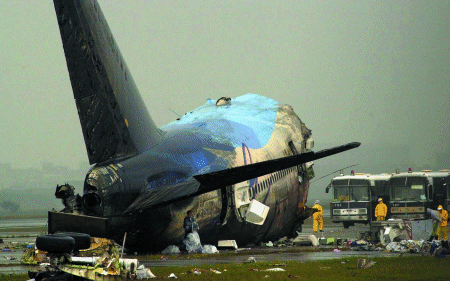Taiwanese investigators are trying to determine why a Singapore Airlines (SIA) Boeing 747-400 which crashed at Taipei on 31 October, attempted to take off on a closed runway. There are conflicting reports on the status of the lights on the closed runway at the time of the accident, which could have confused the flightcrew.

Flight SQ006, bound for Los Angeles, crashed after striking machinery on the runway during take-off from Chiang Kai-Shek International Airport, Taipei, at 23:18h local time. Eighty-one of the 159 passengers and 20 crew on board were killed, and many of the survivors remain in hospital with serious burns and other injuries. All the flight crew, including the Capt Foong Chee Kong, are understood to have survived the accident.
The SIA aircraft was cleared to take off from the active 05L runway, but, according to Taiwanese Aviation Safety Council (ASC) investigators, the aircraft in fact lined up and departed from the parallel 05R. This was closed for maintenance work and obstructed by heavy machinery. "He should have taken off from 05L, but he took off from 05R," says ASC chief investigator Kay Yong.
Weather conditions at the time were poor, with a typhoon approaching Taiwan. There were high winds, reported as 50kt (93km/h) at 020¹, and rain. Visibility was down to 500-600m (1,600-2,000ft). Yong says that the airport does not have ground movement radar and the poor visibility meant that the tower had no visual contact with the aircraft.
Cockpit voice recorder information released by the ASC reveals the crew's final conversations:
23.15.18 Tower: "Wind 020°/50kt, clear for take-off runway 05L."
23.15.26 Capt: "Clear for take-off runway 05L."
23.16.19 Capt: "I can see the runway not so bad," (as the 747 was turning on to 05R).
23.16.51 First officer (F/O): "80kt."
23.16.52 Capt: "OK my control."
23.17.08 F/O: "V1."
23.17.12 Capt: "Shit, something there."
23.17.13 Sound of impact.
23.17.18 Tape ends.
According to Taiwanese investigators, the 747-400's (9V-SPK) first impact was with a concrete "jersey block" barrier 1,000m (3,280) from the beginning of 05R, at which point its nose gear was around 1.8m off the ground. The aircraft then struck machinery and broke apart, with the wreckage coming to rest around 1,000m beyond the concrete blocks.
"There are conflicting reports as to whether 05R's runway side lights were on or off," says Yong. He confirms that, although the runway was closed, its green centreline lights were on as it is normal procedure. The airport's tower controllers report that the side lights were off, but Yong says SIA cabin crew claim they were on. O5R is an auxiliary runway, 15m narrower than the 60m-wide 05L runway, he adds.
A Mandarin Airlines Boeing 737-800 damaged runway lights on 05L at around mid-day the same day, but this is not thought to have made any difference to the use of lights on runway 05R. Earlier, it had been suggested that because of this, 05R had been lit to assist in illumination of 05L.
The disaster is the first fatal accident involving a 747-400, and the second fatal accident in the history of SIA. The first was the December 1997 crash in Indonesia of a Boeing 737-300 operated by SIA subsidiary SilkAir.
Additional reporting by Andrzej Jeziorski in Singapore
Source: Flight International























